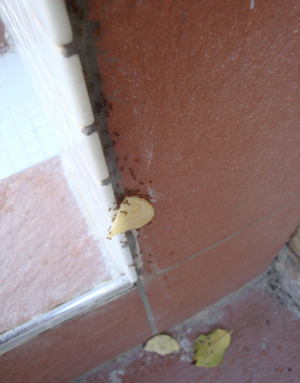Baiting Ants Can Be an Involved Process
By Chris Williams on July 11, 2013.

Question
We’ve had an ongoing ant problem for months, mostly in the kitchen and dining room. I don’t know what kind they are, but they’re tiny so I’m sure they’re not carpenter ants. I bought some of those ant bait stations but they don’t seem to be doing any good at all. Why aren’t they working?
Answer
The downside to baiting for ants is that it can be a slow process. But that’s a good thing. First, the ants have to find the bait, then they have to recruit other ants in the colony to the bait. The foraging ants feed on the bait and carry it back to the colony where it is fed to the larvae, queen, and other workers, eventually affecting the entire colony. If the baits killed the ants as soon as they fed on it, it would never be passed on to the colony. You would only be killing the few foraging ants as they found the bait.
You don’t say how long you’ve had ant baits out. Depending on the bait you’re using and the activity level of the ants, it can take several days to a week to begin seeing results and a couple of weeks to eliminate the colony. If you’ve given the baits time and are seeing no reduction in foraging ants, there are other reasons why the baits may not be working.
Are the ants still going into the bait stations?
If not, it may be that they have already eaten all of the bait. Check the stations and replace those that are empty. If you’ve had the bait stations out for a very long time, the bait may actually be stale and no longer attractive to the ants.
Did you put out enough bait stations?
Follow label directions for placement. If you don’t place enough bait stations, the small amount of bait may be depleted before it has a chance to broadly affect the entire colony.
Are the bait stations in the right places?
Place the stations where you have seen ants trailing, and also near water sources such as sinks, near areas where you have seen ants feeding, and near heat sources like electrical appliances.
Are you offering too many other competing food sources?
If you can, track the ants to see where they are feeding and what they are feeding on. Not all types of ants are equally attracted to ant baits. Those that eat a wider variety of foods are harder to bait successfully. Make sure there aren’t unseen crumbs under the stove, or pet food left out, or a trail of ants going into your garbage can chowing down on something else.
Have you used any insecticides near the bait stations?
That can drive the ants away. Likewise, the use of strong cleaning products around the stations could repel the ants.
Have you tried a different bait?
You may need to change the type of bait you’re using. Some ant species are sweet lovers, while others prefer to feed on greases and fats. And the same species may even change its food preference seasonally. If you have a professional identify the ants, you may get a better idea of the types of food baits they prefer.
Baiting ants successfully can be complicated and time-consuming, and takes a certain amount of knowledge about ant behavior. Sometimes, baiting is not the right answer, or is only part of the right answer. At Colonial, we can set up an ant management program that is specific to your situation—and we guarantee results!
Photo credit: Smallbrainfield / Foter / CC BY-NC